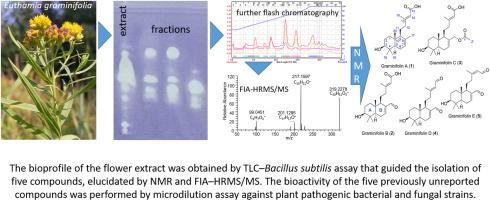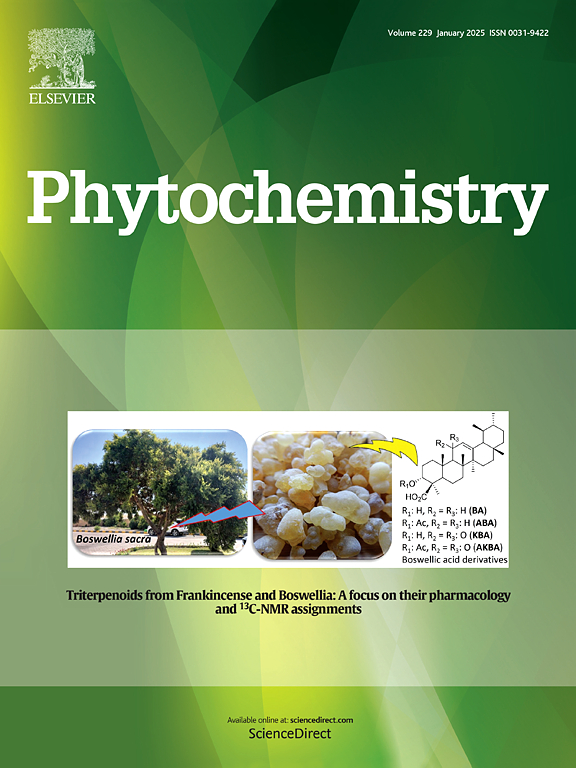Undescribed antimicrobial labdane diterpenes from the flowers of Euthamia graminifolia
IF 3.4
2区 生物学
Q2 BIOCHEMISTRY & MOLECULAR BIOLOGY
引用次数: 0
Abstract
The demand for previously undescribed antimicrobial agents is increasing due to the emergence of resistant plant pathogens. One of the untapped sources of new biopesticides is the plant kingdom. A bioassay-guided process comprising TLC–Bacillus subtilis bioassay, TLC–MS, and preparative flash column chromatography enabled the isolation of five previously undescribed antimicrobial labdane diterpenes (graminifolins A–E, 1–5) from the flower extract of grass-leaved goldenrod (Euthamia graminifolia, formerly known as Solidago graminifolia). Their structures were elucidated by NMR spectroscopy, supported by HRMS/MS, polarimetry, and UV, and ATR–FTIR spectroscopy. Graminifolins A–C (1–3) displayed low to moderate antibacterial and bactericidal activity against the Gram-positive plant pathogens Curtobacterium flaccumfaciens pv. flaccumfaciens and Clavibacter michiganensis, with MIC values between 67 and 533 μg/mL and MBC values ranging from 133 to 533 μg/mL. In contrast, graminifolin D+E (4+5) was active only against C. michiganensis. Among the isolated compounds, graminifolin A exhibited the strongest antibacterial effect and demonstrated weak antifungal activity against the crop pathogen Bipolaris sorokiniana. These findings underscore the potential of bioassay-guided fractionation in discovering previously undescribed bioactive compounds.

禾本科花中未描述的抗菌labdane二萜。
由于抗性植物病原体的出现,对以前未描述的抗菌剂的需求正在增加。植物界是新型生物农药尚未开发的来源之一。采用tlc -枯草芽孢杆菌生物测定、TLC-MS和制备型闪光柱色谱等生物检测方法,从禾草黄花(Euthamia graminifolia,原Solidago graminifolia)的花提取物中分离出5种以前未被描述过的抗菌labdane二萜(graminifolins A- e, 1-5)。通过核磁共振、质谱、极化、紫外、ATR-FTIR等手段对其结构进行了表征。Graminifolins A-C(1-3)对革兰氏阳性植物病原菌Curtobacterium flacfaciens pv表现出低至中等的抗菌和杀菌活性。MIC值为67 ~ 533 μg/mL, MBC值为133 ~ 533 μg/mL。相比之下,谷草素D+E(4+5)仅对密歇根镰刀菌有活性。在分离得到的化合物中,graminifolin A的抑菌效果最强,对作物病原菌双星病菌(Bipolaris sorokiniana)的抑菌活性较弱。这些发现强调了生物测定引导分离在发现以前未描述的生物活性化合物方面的潜力。
本文章由计算机程序翻译,如有差异,请以英文原文为准。
求助全文
约1分钟内获得全文
求助全文
来源期刊

Phytochemistry
生物-植物科学
CiteScore
6.40
自引率
7.90%
发文量
443
审稿时长
39 days
期刊介绍:
Phytochemistry is a leading international journal publishing studies of plant chemistry, biochemistry, molecular biology and genetics, structure and bioactivities of phytochemicals, including ''-omics'' and bioinformatics/computational biology approaches. Phytochemistry is a primary source for papers dealing with phytochemicals, especially reports concerning their biosynthesis, regulation, and biological properties both in planta and as bioactive principles. Articles are published online as soon as possible as Articles-in-Press and in 12 volumes per year. Occasional topic-focussed special issues are published composed of papers from invited authors.
 求助内容:
求助内容: 应助结果提醒方式:
应助结果提醒方式:


